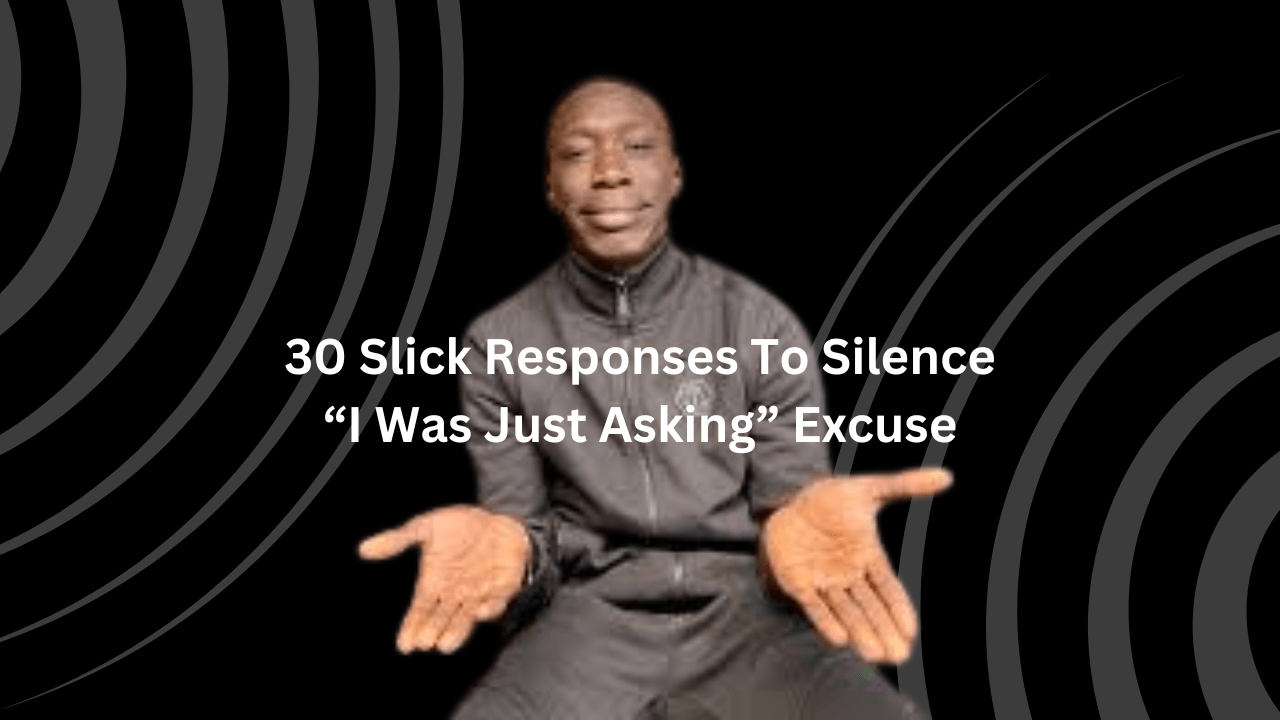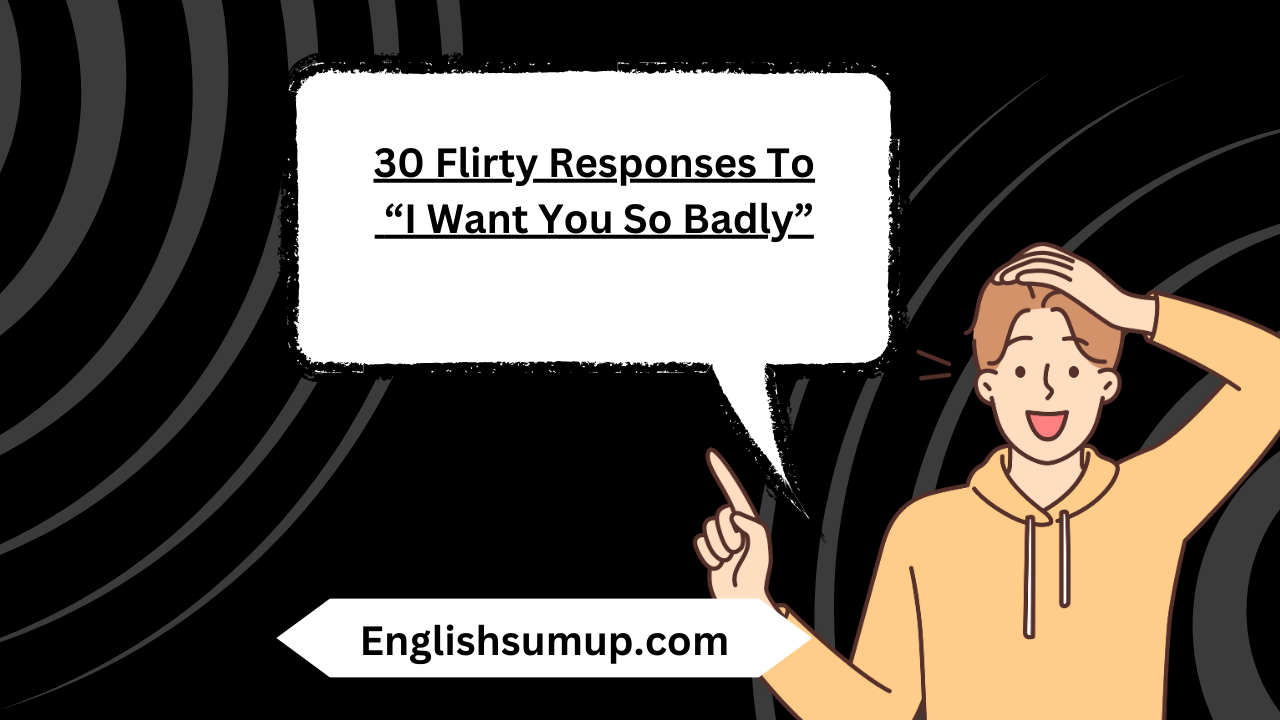In the realm of communication, we often encounter situations where our boundaries are tested and dismissive remarks are used to downplay our concerns or discomfort. One such common excuse is “I was just asking.” While it may seem innocuous, this excuse can be used to deflect responsibility and dismiss valid concerns. In this article, we’ll explore 30 slick responses to silence the “I was just asking” excuse, offering bold and witty comebacks to assert boundaries and maintain control of conversations.
Understanding the Excuse:

Before delving into the responses, it’s essential to understand the intention behind the “I was just asking” excuse. This phrase is often used to deflect criticism or avoid accountability for intrusive or inappropriate questions. By responding assertively to this excuse, we assert our boundaries and communicate that such dismissive behavior is not acceptable.
Quick Tips for Responding Assertively:
Before we dive into the responses, here are some quick tips for responding assertively to the “I was just asking” excuse:
Stay composed: Maintain your composure and confidence in your response.
Assert your boundaries: Clearly communicate that such dismissive behavior is not acceptable.
Use humor and wit strategically: Employ humor and wit to disarm the situation and maintain control of the conversation.
You may love this : 23 Ways to Respond to “I’m Not Looking For Anything Serious”
Now, let’s explore 30 slick responses to the “I was just asking” excuse:

“And I’m just declining to answer.”
This response asserts the individual’s right to withhold information or decline to answer intrusive questions. It communicates that the individual is not obligated to respond to every inquiry and is exercising agency over their personal information.
“Well, I’m just asserting my boundaries.”
By stating that they are asserting their boundaries, this response communicates that the individual is setting limits on what types of questions they are willing to answer. It establishes that the individual expects their boundaries to be respected in conversation.
“Funny, I thought respect for boundaries was just common courtesy.”
This response challenges the idea that respecting boundaries is optional or trivial. It emphasizes that respecting boundaries is a fundamental aspect of courteous communication and suggests that the other person’s behavior is disrespectful.
“I’m just exercising my right to privacy.”
By citing their right to privacy, this response communicates that the individual is entitled to keep certain information private. It asserts that privacy is a valid concern and should be respected in conversation.
“Ah, I see. And I’m just exercising my right to shut down inappropriate questions.”
This response acknowledges the excuse while asserting the individual’s right to reject inappropriate questions. It communicates that the individual is taking action to shut down intrusive or disrespectful behavior.
“Interesting. I was just asking you to mind your own business.”
By turning the tables and asking the other person to mind their own business, this response highlights the hypocrisy of the excuse. It suggests that the other person’s question was inappropriate or intrusive.
“How about we just change the subject?”
This response suggests redirecting the conversation to a different topic, effectively ending the discussion about the intrusive question. It communicates a desire to move past the uncomfortable topic and maintain a more positive conversation.
“I appreciate your curiosity, but some things are best left unsaid.”
This response acknowledges the other person’s curiosity while asserting that certain topics should remain private. It communicates a boundary around what types of information the individual is willing to share.
“I understand you were asking, but I’m choosing not to engage.”
By acknowledging the question while declining to engage with it, this response communicates that the individual is actively choosing not to participate in the discussion. It asserts the individual’s agency in deciding which conversations to participate in.
“Not answering is just my way of saying ‘no thank you’ to intrusive questions.”
This response reframes the act of not answering as a polite way of declining to engage with intrusive questions. It communicates that the individual is asserting their boundaries in a respectful manner.
“I was just responding with silence to invasive inquiries.”
This response emphasizes that silence can be a deliberate and meaningful response to invasive questions. It communicates that the individual is using silence as a way to assert their boundaries and signal discomfort with the line of questioning.
“And I’m just responding with assertiveness to disrespectful behavior.”
By linking their response to assertiveness, this comeback asserts the individual’s right to respond assertively to disrespectful behavior. It communicates that the individual is standing up for themselves in the face of inappropriate questioning.
“Well, I’m just asking you to respect my boundaries.”
This response flips the script and turns the excuse back on the person making the intrusive inquiry. It communicates that the individual expects their boundaries to be respected and challenges the other person to do the same.
“Consider my silence as a gentle reminder to respect personal space.”
By framing their silence as a gentle reminder, this response communicates that the individual is using non-verbal cues to assert their boundaries. It suggests that the other person should take note and adjust their behavior accordingly.
“I was just responding with assertiveness to maintain control of the conversation.”
This response highlights that assertiveness is a tool for maintaining control of the conversation. It communicates that the individual is taking charge of the interaction and steering it in a direction that feels comfortable and respectful.
“Ah, so you were just asking. And I’m just declining to engage.”
This response acknowledges the excuse while firmly declining to engage with it. It communicates that the individual is not interested in entertaining intrusive questions and is actively choosing to disengage from the conversation.
“I was just using silence as a form of boundary-setting.”
By framing their silence as a form of boundary-setting, this response communicates that silence can be a powerful tool for asserting boundaries. It suggests that the other person should take heed and respect those boundaries.
“Interesting. And I’m just asserting my right to privacy.”
This response emphasizes the individual’s right to privacy and communicates that certain topics are off-limits for discussion. It asserts that privacy is a valid concern and should be respected by others.
“And I’m just exercising my right to set boundaries.”
By asserting their right to set boundaries, this response communicates that the individual expects their boundaries to be respected in conversation. It suggests that the other person should be mindful of these boundaries and refrain from crossing them.
“Consider my lack of response as a subtle lesson in respecting boundaries.”
This response reframes the lack of response as a teaching moment for the other person. It communicates that the individual is using their actions to demonstrate the importance of respecting boundaries in conversation.
“I was just asking you to respect my privacy.”
This response directly addresses the issue by stating that the individual’s privacy is being infringed upon. It communicates that the other person’s questioning is inappropriate and underscores the importance of respecting personal boundaries.
“Well, I was just using silence as a tool to assert my boundaries.”
By explaining their use of silence as a boundary-setting tool, this response clarifies the intention behind their non-verbal communication. It communicates that the individual is actively asserting their boundaries and expects them to be respected.
“I understand you were just asking, but some questions cross the line.”
This response acknowledges the other person’s intention while firmly stating that certain questions are unacceptable. It communicates that the individual has clear boundaries regarding what topics are appropriate for discussion.
“And I’m just using assertiveness to protect my personal space.”
By linking assertiveness to the protection of personal space, this response emphasizes the importance of maintaining boundaries. It communicates that the individual is actively safeguarding their privacy and expects others to do the same.
“Interesting. And I’m just asserting my right to keep certain things private.”
This response asserts the individual’s right to keep certain information private. It communicates that privacy is a fundamental right and should be respected by others, regardless of their curiosity.
“I appreciate your curiosity, but some things are better left unsaid.”
By acknowledging the other person’s curiosity while asserting the importance of discretion, this response strikes a balance between politeness and assertiveness. It communicates that some topics are off-limits for discussion and should be respected as such.
“Well, I was just asking you to respect my boundaries.”
This response flips the excuse back on the other person, reminding them that respecting boundaries is a two-way street. It communicates that the individual expects their boundaries to be respected and will assertively enforce them if necessary.
“Consider my lack of response as a polite way of saying ‘no comment.'”
This response uses humor to deflect the invasive question and assert boundaries. It communicates that the individual is declining to engage with the question in a polite yet assertive manner.
“I understand you were just asking, but some questions are off-limits.”
This response acknowledges the other person’s intention while firmly stating that certain questions are unacceptable. It communicates that the individual has clear boundaries regarding what topics are appropriate for discussion.
“And I’m just exercising my right to keep certain matters private.”
This response reiterates the importance of privacy and asserts the individual’s right to keep certain information confidential. It communicates that the individual will not be pressured into divulging information that they wish to keep private.
Tailoring Your Response:
When responding to the “I was just asking” excuse, it’s essential to tailor your response to the situation and your relationship with the person making the excuse. Consider the tone and context of the conversation, and choose a response that asserts your boundaries while maintaining respect and composure.
Importance of Assertive Communication:
Assertive communication is crucial in setting boundaries, fostering mutual respect, and maintaining control of conversations. By responding confidently to dismissive remarks like the “I was just asking” excuse, we assert our boundaries and communicate that such behavior is not acceptable.
Conclusion:
In conclusion, providing slick responses to dismissive excuses like “I was just asking” is essential for asserting boundaries and maintaining control of conversations. By employing bold and witty comebacks, we communicate that intrusive or inappropriate questions are not acceptable and assert our right to privacy and respect. So, the next time you encounter the “I was just asking” excuse, choose one of these responses to assert your boundaries and maintain control of the conversation.









